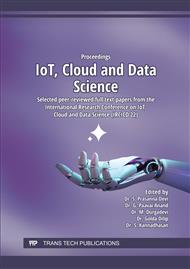[1]
de Oliveira, Nicollas R., Pedro S. Pisa, Martin A. Lopez, Dianne S.V. de Medeiros, and Diogo M.F. Mattos. 2021. Identifying Fake News on Social Networks Based on Natural Language Processing: Trends and Challenges, Information 12, no. 1: 38. Doi: /10.3390/info12010038.
DOI: 10.3390/info12010038
Google Scholar
[2]
Nasiba Mahdi Abdulkareem & Adnan Mohsin Abdulazeez, 2021. Machine Learning Classification Based on Radom Forest Algorithm: A Review,, International Journal of Science and Business, IJSAB International, vol. 5(2), pages 128-142. RePEc:aif: journal: v:5:y:2021:i:2:p:128-142.
Google Scholar
[3]
Saleh Hussein, Ameer, Rihab Salah Khairy, Shaima Miqdad Mohamed Najeeb, and Haider Th.Salim Alrikabi. 2021. Credit Card Fraud Detection Using Fuzzy Rough Nearest Neighbor and Sequential Minimal Optimization With Logistic Regression,. International Journal of Interactive Mobile Technologies(iJIM)15(05):pp.24-42.
DOI: 10.3991/ijim.v15i05.17173
Google Scholar
[4]
Yu, Yinshan, Mingzhen Shao, Lingjie Jiang, Yongbin Ke, Dandan Wei, Dongyang Zhang, Mingxin Jiang, and Yudong Yang. Quantitative analysis of multiple components based on support vector machine (SVM)., Optik 237 (2021): 166759.
DOI: 10.1016/j.ijleo.2021.166759
Google Scholar
[5]
Giannakas, Filippos, Christos Troussas, Akrivi Krouska, Cleo Sgouropoulou, and Ioannis Voyiatzis. XGBoost and deep neural network comparison: The case of teams' performance., In International Conference on Intelligent Tutoring Systems, pp.343-349. Springer, Cham, 2021.
DOI: 10.1007/978-3-030-80421-3_37
Google Scholar
[6]
Sarker, Iqbal H. Machine learning: Algorithms, real-world applications, and research directions., SN Computer Science 2, no. 3 (2021): 1-21.
Google Scholar
[7]
Gozum, Ivan Efreaim A., Harvey Gain M. Capulong, Joseph Renus F. Galang, and Jose Ma W. Gopez. An ayuda to the least advantaged: providing a program for those who were hit the hardest during the COVID-19 pandemic., Journal of Public Health 43, no. 2 (2021): e317-e318.
DOI: 10.1093/pubmed/fdab014
Google Scholar
[8]
Powers, David & Ailab,. (2011). Evaluation: From precision, recall and F-measure to ROC, informedness, markedness & correlation. J. Mach. Learn. Technol. 2. 2229-3981. 10.9735/2229-3981.
Google Scholar
[9]
H. Hairani, A. Anggrawan, A. I. Wathan, K. A. Latif, K. Marzuki and M. Zulfikri, The Abstract of Thesis Classifier by Using Naive Bayes Method,, 2021 International Conference on Software Engineering & Computer Systems and 4th International Conference on Computational Science and Information Management (ICSECS-ICOCSIM), 2021, pp.312-315,.
DOI: 10.1109/icsecs52883.2021.00063
Google Scholar
[10]
Yanfeng Zhang and Peikun He, A revised AdaBoost algorithm: FM-AdaBoost,, 2010 International Conference on Computer Application and System Modeling (ICCASM 2010), 2010, pp. V11-277-V11-281,.
DOI: 10.1109/iccasm.2010.5623209
Google Scholar
[11]
X. Yu and X. yu, The Research on an Adaptive k-Nearest Neighbors Classifier,, 2006 5th IEEE International Conference on Cognitive Informatics, 2006, pp.535-540,.
DOI: 10.1109/coginf.2006.365542
Google Scholar
[12]
C. Jun, Z. Fan, and F. Shan, Building up multi-layered perceptrons as classifier system for decision support,, in Journal of Systems Engineering and Electronics, vol. 6, no. 2, pp.32-39, June (1995).
Google Scholar
[13]
M. Wozniak, Experiments with Boosted Decision Tree Classifiers,, 2008 Eighth International Conference on Intelligent Systems Design and Applications, 2008, pp.552-557,.
DOI: 10.1109/isda.2008.215
Google Scholar
[14]
S. Yamaki, S. Seki, N. Sugita and M. Yoshizawa, Performance Evaluation of Cross Correlation Functions Based on Correlation Filters,, 2021 20th International Symposium on Communications and Information Technologies (ISCIT), 2021, pp.145-149,.
DOI: 10.1109/iscit52804.2021.9590596
Google Scholar


